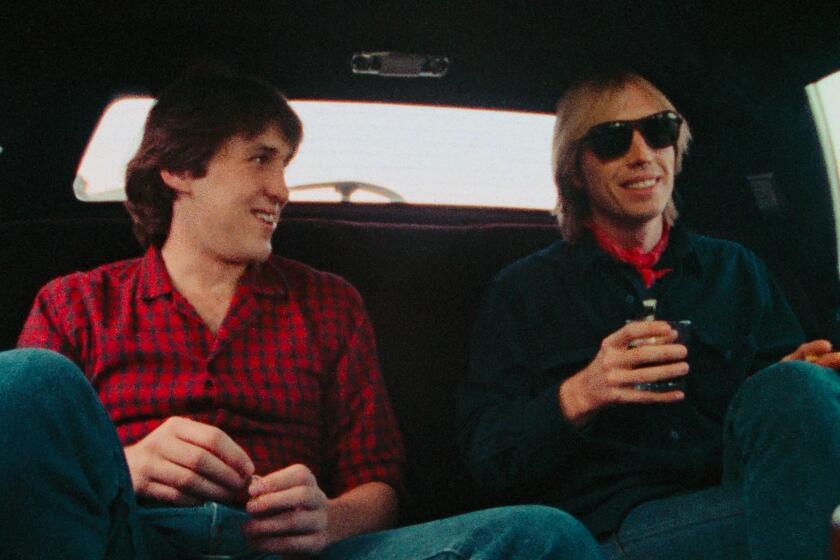Review: Errol Morris reveals subject’s charm in doc ‘The B-Side: Elsa Dorfman’s Portrait Photography’
Large pictures, small joys and an archive’s radiance are the building blocks for the charm offensive that is “The B-Side: Elsa Dorfman’s Portrait Photography,” Errol Morris’ winning documentary about his unsung artist friend, a fixture in Cambridge, Mass., whose specialty is large-format Polaroids and the inviting intimacy she draws from her subjects.
Since 1980, this unassuming practitioner of the pose/click arts has worked with one of a half-dozen or so of the big, boxy 20x24 cameras handmade by the company’s founder, Edwin H. Land. “The B-Side” will make you believe the one in Dorfman’s studio is the only one that’s ever mattered.
Morris’ interests have typically taken him into dark corners, mostly pertaining to death, existence, war, broken systems and injustice. To get what he’s wanted from his interviewees — and to allow us to see them the way Morris questions them he invented a device called the Interrotron, which lets us lock eyes with Donald Rumsfeld (“The Unknown Known”) or Robert McNamara (the Oscar-winning “The Fog of War”).
But this time around, he’s taken off his inquisitor’s cap, set aside the Interrotron — Dorfman is clearly talking to the side of the lens — and settled in like a kid given a private tour of the toy store. He’s in an uncommonly sweet, celebratory mode here. This is the rare Morris movie that feels led by the personality of its star figure, in this case Dorfman’s wry positivity and love of what she does, rather than his need to probe. You can almost sense Morris smiling off-camera as she pulls each exposure from her file drawers for reminiscing and newfound scrutiny — that’s how strong and warm his admiration is for Dorfman and the humble richness of her work.
Dorfman had been a young secretary in New York at legendary Beat publisher Grove Press in the 1960s, where she befriended authors like Allen Ginsberg. But during her studies in Boston to get a teaching degree, a colleague handed her a Hasselblad camera, and the leap to photographer was instantaneous. She started with self-portraits and candid grabs of noteworthy pals — Ginsburg, Robert Creeley, Andrea Dworkin — selling prints for $2 out of a shopping cart in Harvard Square. (“Singular Opportunity,” her sign sunnily promised.)
She published a book of photographs in 1974 — subtitled “A Woman’s Photojournal” — and soon after, Polaroid brought out Land’s 200-pound behemoth. After first renting it, and discovering how its sense of scale matched her own ambitions, she turned to commissioned large-scale portraiture full time. Ginsberg was her first 20x24 subject in 1980 — “he wasn’t guarded, he would disarm himself” — and pictures of him across their lifelong friendship, and of her husband, civil rights lawyer Harvey Silverglate, form a kind of emotional throughline in “The B-Side.”
The title is a kind of affirmation of the journeywoman’s aesthetic sensibility. Dorfman could only afford to produce two exposures for each client, so the unchosen picture became the “B.” Yet she’s loath to consider them rejects, finding beauty in mis-processed color, imperfections or closed eyes. “This is not a bad blink,” she says, holding one photograph. Her aim is not to unearth the soul, she says, but to capture people at their surest about who they are. If anything, the smiling families, flamboyant posers and instantly snapped/instantly enjoyed expressions of joie de vivre amount to a yearslong examination of the picture-taker as well: Dorfman’s own ebullience can’t help but infuse every photograph.
A tinge of melancholy punctures this appealing character study, though, when the movie addresses her dwindling stock of film and chemicals in the wake of Polaroid’s de facto end as a company. Her medium obsolete, Dorfman is practically retired now. She was never an art darling or sought-after photographer or even one of artist-friendly Polaroid’s “pets,” she says. But she’d found her calling, and discovered her perfect tool, and as Morris’ movie makes beautifully clear, that was everything.
-------------
‘The B-Side: Elsa Dorfman’s Portrait Photography’
Running time: 1 hour, 16 minutes
Rating: R, for some graphic nude images and brief language
Playing: Laemmle Royal, West L.A.
See the most-read stories in Entertainment this hour »
Movie Trailers
More to Read
Only good movies
Get the Indie Focus newsletter, Mark Olsen's weekly guide to the world of cinema.
You may occasionally receive promotional content from the Los Angeles Times.










